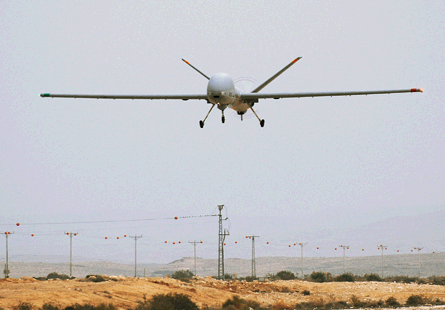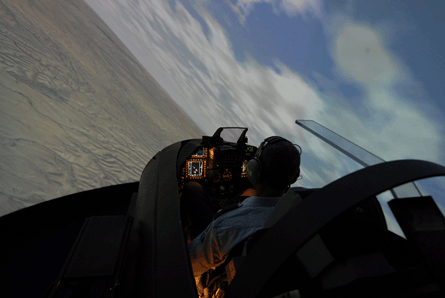Measured against any standard, Elbit Systems has turned in a remarkable decade. The company, founded in 1966 as a computer and electronics specialist, now ranks among the world's 40 largest defence firms, with the majority of its growth swiftly accumulated over the past 10 years.
It has been a good decade, of course, for almost any business offering predominantly military products. The Stockholm International Peace Research Institute estimates that worldwide military spending grew by about 50% between 1998 and 2008. Several aerospace and defence companies, such as Elbit's neighbour Israel Aerospace Industries, saw their revenues double over the decade.
Elbit, however, grew significantly faster. The company's annual sales doubled to $900 million within the first half of the decade. Then, between 2004 and 2009, revenues nearly tripled to $2.6 billion. Overall growth over the 10-year period approaches 700%.
 |
|---|
© Elbit SystemsThe Hermes family of unmanned systems has contributed to global awarness of Elbit |
The company has established global awareness with its family of Hermes and Skylark unmanned air systems, helmet-mounted displays, aircraft upgrades and satellite imagery. But the source of the company's growth is not by virtue of organic growth alone.
Driving Elbit's financial success since 1998 were a series of major acquisitions within Israel and elsewhere. The initial leap came with the merger of Elbit and El-Op, a previous competitor in the electro-optics market.
That deal not only doubled the company's size overnight, but installed El-Op executive and Israeli hotel magnate Michael Federmann as chairman of the combined firm. Federmann is now the largest shareholder, controlling 45% of stock. Meanwhile, Elbit chief executive officer David Ackerman has remained in place over the 10-year growth period.
Elbit's next acquisition target focused in 2004 on Cyclone Aviation Products, cleaved from Israel Military Industries, then in the throes of a financial crisis. Now a wholly owned subsidiary of Elbit, Cyclone has added an aerostructures business, including advanced composites manufacturing, to the mostly avionics and electronics portfolio of Elbit and El-Op.
ACQUISITIONS
In 2005, this bigger and stronger Elbit launched a three-year process to fully acquire Israel-based Tadiran Communications, adding to the company's order backlog a globally prized contract to digitise the communications systems across the Israeli defence forces. In 2007, Elbit also acquired Elisra, one of Israel's premier electronic warfare houses.
Although Israel's once-flourishing community of medium-sized defence businesses has been wiped out by acquisition, Elbit's buying spree continues. In 2009, it added two healthy Israeli aerospace and electronics firms - BVR and Mikal - to the list of its subsidiaries.
Sustaining Elbit's growth curve will not be easy. Further consolidation of the Israeli defence industry is only possible with a dramatic change in government policy, finally allowing Elbit, Rafael, IMI and IAI to deal with each other on a large scale.
"What will happen to the government [policy] I really don't know. This is definitely something everybody will look at, including us," Moshe Shahom, deputy vice-president of business development and marketing at the El-Op subsidiary "Apart from that, there's nothing [left for Elbit to buy], I think."
Barring an unexpected policy shift, Elbit can look to foreign markets to maintain its growth trajectory. The company has an established base already in the USA. Of 2,600 employees working outside Israel, Elbit employs 2,100 in the USA alone, working at subsidiaries such as Kollsman and EFW.
Making new acquisitions in the USA requires a government review process, but Elbit has demonstrated that it can get acquisitions approved. "The proof is in the pudding. The fact is they have enabled us to acquire US companies," says Benjamin Weiser, senior director, business development, helicopter upgrades. "Of course, the US is very careful and there are security concerns. But they have allowed us to make acquisitions in the US."
GLOBAL TRENDS
Elbit's acquisition-fuelled growth is largely viewed as a response to global trends affecting aerospace and defence companies. The consolidation of European and US industry that started in the 1990s increased the size and resources of firms competing with Israeli companies on the export market, which accounts for more than 70% of Elbit's order backlog.
Besides the global consolidation trends, Elbit's business strategy also must anticipate higher competition overseas as financial pressures force militaries to cut spending.
In competition on foreign territory, Elbit shares with other Israeli companies a unique diversity of technological expertise, combat-proven products and a liberal attitude to technology transfer and industrial offset policies.
Elbit, however, stands apart among the four major Israeli arms companies - IAI, IMI and Rafael - as the only multi-billion dollar, aerospace and electronics business in Israel not owned by the government.
Elbit's privatised status lends the company a certain swagger. A popular anecdote told by its executives involves a presentation to two potential Australian investors about the company's satellite imagery business. Elbit had the EROS A satellite take photos of one of the businessmen's ranch in Australia, allowing the executive to count his sheep using a picture snapped from a distance of 400-500km (250-310 miles). But the marketing stunt "didn't convince them. They didn't buy the shares eventually," Shahom says.
 |
|---|
© Elbit SystemsElbit provides digital cockpits, head-up displays and control panels for dozens of aircraft |
Elbit, however, has more freedom than its Israeli competitors to reach out to capital markets and make acquisitions, bypassing required approvals from the government committees that Rafael and IAI must face.
Despite its comparative freedom and phenomenal growth, Elbit has retained a rigid discipline on where it decides to compete.
"We try to be first, or at least one of three," says Weiser. "If we're not one of three in an area, we didn't go into that area. It's something that our president has dictated over the years." That philosophy has kept Elbit out of the radar business, a market dominated by Northrop Grumman, Raytheon, Thales, Selex and fellow Israeli supplier Elta Systems.
Instead, the company focuses its resources in technologies where it maintains a competitive edge. One example is the field of helmet-mounted display and avionics systems. Vision Systems International, a joint venture between Elbit and Rockwell Collins, has the contract to develop the advanced helmet for F-35 pilots. "With our internal research and development, a lot of that goes into our helmet systems because we want to maintain our edge," Weiser says.
That strategy is the force behind the Jeteye helmet. Elbit had purchased the Honeywell helmet product line for the Boeing AH-64 Apache, which is called the integrated helmet display and sighting system (IHADSS). It has improved on that with the Jeteye system, now nearing the end of its development phase.
"We call it the 'wow helmet'," Weiser says. "First we show [potential customers] what they see with the current IHADSS helmet, which is a 40° x 30° image with about 525 lines of resolution. And then we flip a switch and go to the Jeteye helmet, which is 80° x 40° with 1,200 lines for each eye. Invariably we get a 'wow'."
Elbit is also investing in the UAS business. It has formed a joint venture in the USA with General Dynamics called UAS Dynamics, which is offering a derivative of the Hermes 90 called Storm. Meanwhile, it is continuing to seek final clearances from the UK authorities to transfer the Hermes 450 for the Watchkeeper programme to Parc Aberporth in Wales for more flight testing.
Aircraft upgrades remain in high demand, particularly for increasingly ageing fighter and helicopter fleets. Elbit provides a full suite of digital glass cockpits, head-up displays, control panels and colour displays for dozens of aircraft of both Western and Eastern origin. One example is the Russian RSK MiG-29.
"In the MiG-29, to get an air-to-air missile off you need seven or eight different actions," says Weiser. "When you're in a stressful, high-workload environment you don't have time to start flipping buttons."
Elbit has experience upgrading 25 different types of helicopters, many of Russian manufacture. A key initiative now is to convert transport helicopters into armed gunships.
"We think that's something that's going to be a trend: taking a transport helicopter like the Black Hawk and weaponising it," Weiser says. "Helicopters have taken on a new significance. Countries are screaming for transport and lift capability in Afghanistan to get off the roads there."
Source: Flight International



















